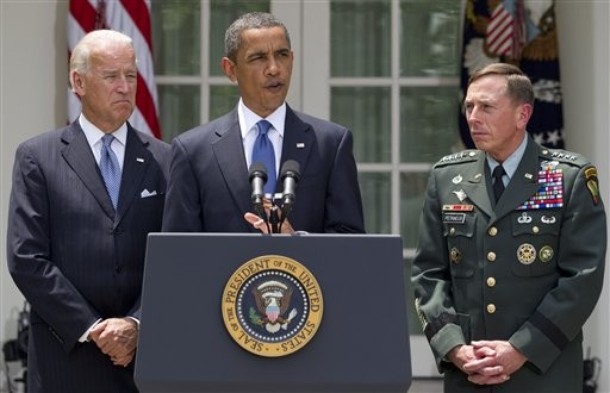
From Rajiv Chandrasekaran, the Washington Post: Military leaders and President [Barack] Obama’s civilian advisers are girding for battle over the size and pace of the planned pullout of U.S. troops from Afghanistan this summer , with the military seeking to limit a reduction in combat forces and the White House pressing for a withdrawal substantial enough to placate a war-weary electorate.
Gen. David H. Petraeus, the top allied commander in Afghanistan, has not presented a recommendation on the withdrawal to his superiors at the Pentagon, but some senior officers and military planning documents have described the July pullout as small to insignificant, prompting deep concern within the White House.
At a meeting of his war cabinet this month, Obama expressed displeasure with such characterizations of the withdrawal, according to three senior officials with direct knowledge of the session. “The president made it clear that he wants a meaningful drawdown to start in July,” said one of the officials, who, like the others, spoke on the condition of anonymity to share internal discussions.
The divergent views about the withdrawal illustrate the unresolved tensions between Obama’s military and civilian advisers over the decision to send more troops to Afghanistan in a last-ditch attempt to salvage a failing war. Although military officials contend that the surge has enabled U.S. forces to blunt the Taliban in key areas over the past several months, White House officials remain skeptical that those gains will survive without the presence of American troops and without U.S. financial aid. …
As both sides prepare for what they expect to be a vigorous debate, they are seeking ways to achieve their favored outcome by limiting what the other can do. For the military, that means crafting a narrow set of choices, because there is general agreement that reduction numbers need to originate in the field, not be imposed by the White House. But the National Security Council may attempt to impose its own limitations by setting a date by which all the surge forces must be brought home, the officials said.
Although Obama approved a 30,000-troop increase sought by the military in 2009, he made clear that the surge forces would begin returning home by July 2011. But the pace of that reduction has been in dispute since the president’s surge announcement, with Defense Department officials describing the initial reductions as minor and some of Obama’s other advisers, including Vice President [Joe] Biden, saying the pullout would be as rapid as the deployment of the surge troops. …
Two senior military officials said one set of options being developed by staff officers in Kabul involves three choices: the removal of almost no forces; the withdrawal of a few thousand support personnel, including headquarters staff, engineers and logisticians; and the pullout of a brigade’s worth of troops — about 5,000 personnel— by culling a battalion of Marines in Helmand province that was added after the surge, a contingent of soldiers training Afghan security forces and an Army infantry battalion in either the country’s east or far west.
The officers said Petraeus had not approved the list. They said they expected that a version of the support-personnel withdrawal, perhaps with some combat forces added to the mix, would be the most likely recommendation. …
Under one approach being seriously considered by the National Security Council, the White House would seek to impose a date by which all 30,000 surge troops would need to be removed but that would give Petraeus and his successor the flexibility to determine the pace of the withdrawal, two of the civilian officials said.
That would be similar to the approach Obama used to reduce U.S. forces in Iraq, where he declared that the military would have to cut troop levels to 50,000 by August 2010 but left it to Gen. Ray Odierno, then the top commander in Iraq, to set the glide slope of withdrawal.
The Afghanistan date is still under discussion — the final decision would be made by Obama — but one option would be to set it in the fall of 2012, which would be two years from the arrival of the last wave of surge forces. (photo: AP)
Image: ap%203%2031%2011%20Joe%20Biden%20Barack%20Obama%20David%20Petraeus.jpg
